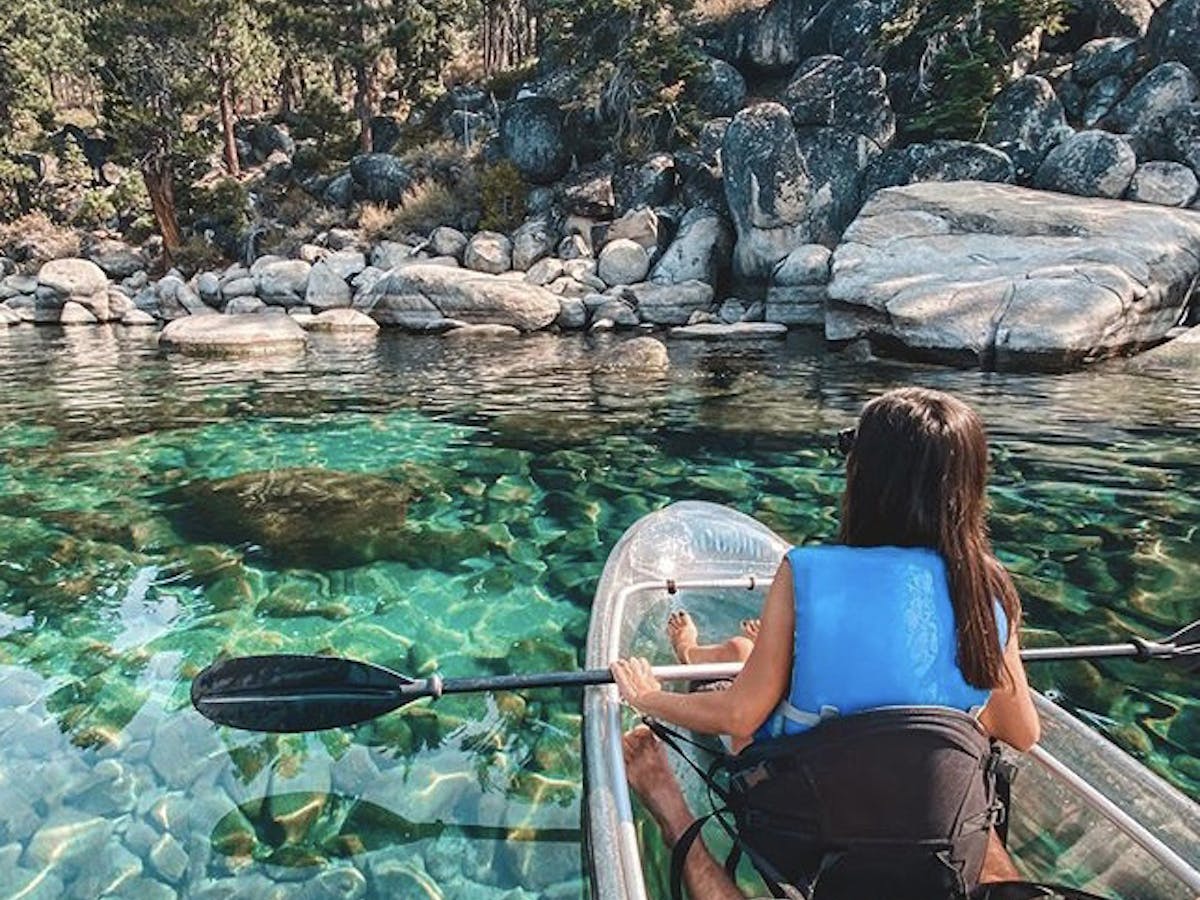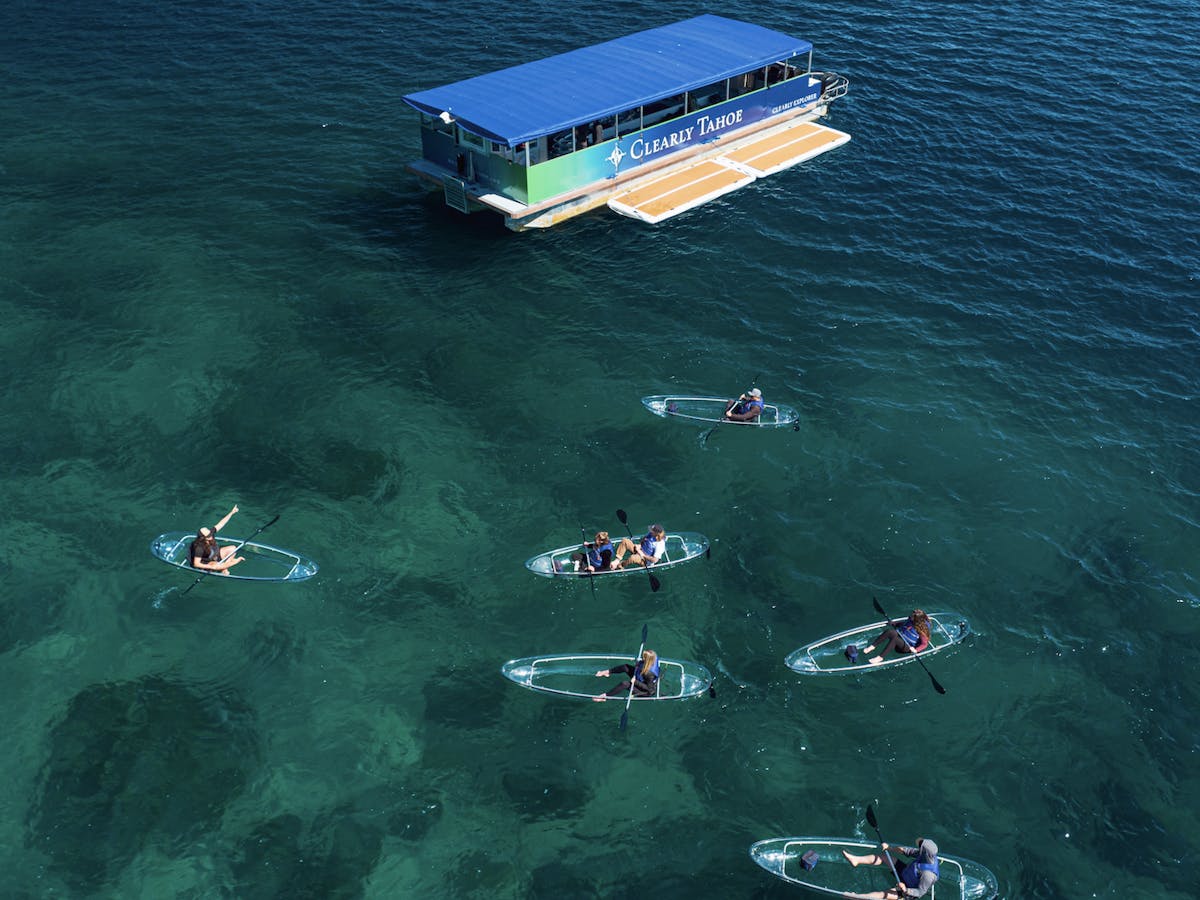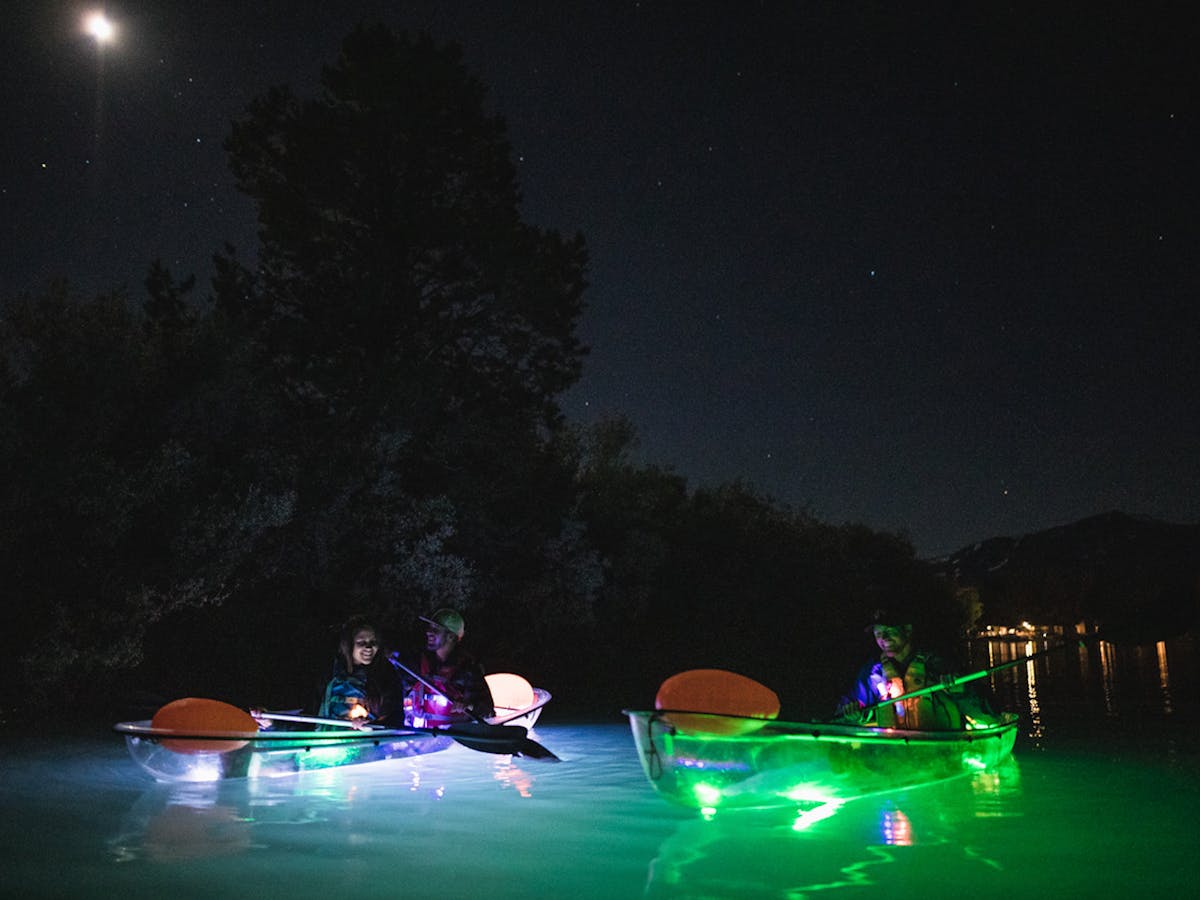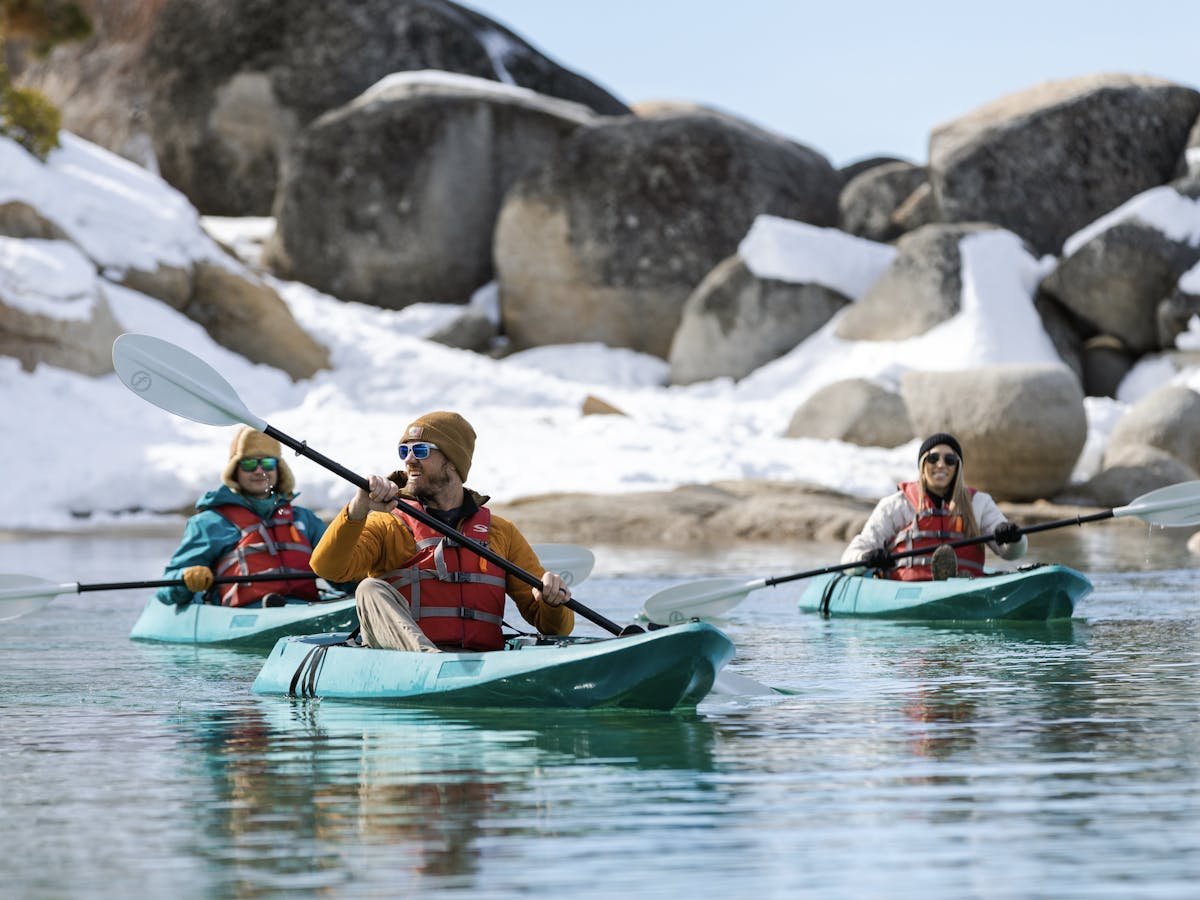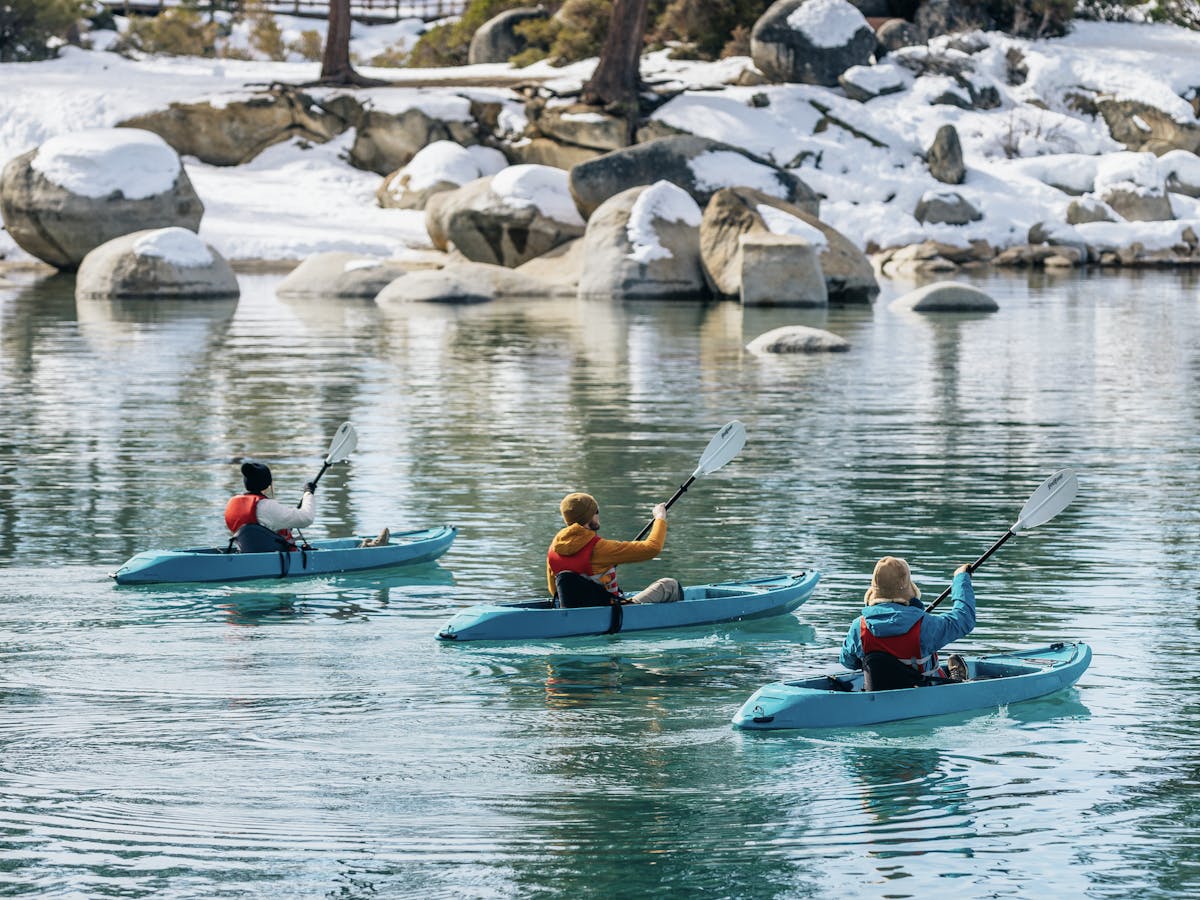Clearly Tahoe 2023 Tour List
Explore the crystal clear waters of Lake Tahoe on one of our early-morning Shoreline Tours, enjoy an array of wildlife on one of our Eco Adventures or kick back and relax under the bright night sky on one of our LED Experiences!
Clearly Tahoe now offers a variety of recreational experiences to enjoy both on as well as off the water and activities suitable for all ages and skill levels (6+). Choose a solo adventure or something the whole family can enjoy together! NOW offering year-round activities in the Lake Tahoe area!
- Pet Friendly: NO
- Limitations: Ages 6+
-
Inclusions:
This guided tour includes shuttle transportation to and from our check in location to the launch site of the scheduled tour. This activity also includes basic instruction from an experienced guide, the use of kayaks, paddles and dry bags as well as a small cooler with complimentary water and granola bars.- Clear Kayak(s) and Paddle(s)
- USCG Approved Life Preserver(s)
- Basic Instruction
- Guided Tour
- Small Cooler
- Complimentary Water
- Granola Bars
- Dry Bags
- Sunscreen
Exclusions:
- Gratuity
Note: There will be complimentary shuttle transportation for this activity. All shuttles are scheduled to depart from our North Clearly Tahoe Shop in Incline Village, NV. Guests must arrive 15 minutes before their scheduled activity for check in. Address below:
Incline Village Shop
893 Tahoe Blvd., Ste 800
Incline Village, NV 89451 -
Adult/Adult Double (ages 18+): – $218Additional Fees:
-
Recommendations:
What to Wear;
Guests should wear comfortable light layers as well as shoes that can be removed easily. We highly recommend hats, sunglasses, and sunscreen, swimsuits are optional but not required.What to Bring;
- Hat
- Sunscreen
- Sunglasses
- Towel (optional)
- Camera!
Please note: While our guests tend to stay relatively dry during this experience, all participants and belongings are subject to getting wet. Clearly Tahoe is not responsible for any lost or damaged items. Electronics and valuables should be left in a safe place.
-
Limitations:
Details for Physical Requirements:
Guests should be able to listen and understand rules, regulations, and safety lecture verbally provided in English. Guests will be required to enter up to 12 inches of water prior to entering the vessel. Guests will be required to enter the vessel one foot at a time and lower themselves to a seated position without assistance. Guests will be required to sit in an upright position and paddle at a reasonable pace with occasional breaks. Guests should be able to remain afloat with the assistance of a PFD and calmly follow instructions of a tour guide in an emergency scenario.Any special requests for guests with disabilities should be referred to [email protected] prior to making a reservation.
Please visit the link below for our full Clearly Tahoe Company Policies
View Clearly Tahoe Full Company Policies.pdf -
Check-in Policy:
Guests MUST arrive to our Clearly Tahoe Shop 15 minutes prior to scheduled activity for check-in. All participants must be prepared to complete electronic liability waivers prior to departure. Guests who miss their scheduled check in may miss their tour and will be subject to same day cancellation policies.Address
Incline Village Shop
893 Tahoe Blvd., Ste 800
Incline Village, NV 89451Meeting Location
Our North Clearly Tahoe Shop is located in the Village Plaza across from Starbucks in the same building as Sage Leaf restaurant and Vista Trail Bikes.Please note: No parking will be available at the Sand Harbor Nevada State Park. Guests who attempt to drive to the Sand Harbor Nevada State Park may miss their shuttle and will be subject to same-day cancellation policies without refund.
ALL GUESTS MUST ARRIVE 15 MINUTES EARLY FOR CHECK-IN
-
Reservation Changes/Cancellation:
Please Note: any reservation changes or requests to cancel should be made as soon as possible. Reservation changes made within 48 hours of a tour are not guaranteed and will be non-refundable and/or subject to additional fees.Reservation changes can be made here or by visiting the “Change or Cancel my Reservation” link at the bottom of the page. This form is required for all customer requested changes or cancellations. For last-minute changes within 48 hours, please also contact our reservation office directly at (530)554-4664 or by email at [email protected] for immediate assistance.
Clearly Tahoe reserves the right to cancel a scheduled tour at anytime due to weather, road conditions, or uncontrollable factors. If a tour is cancelled by Clearly Tahoe guests will be offered a full refund and rescheduling options when possible.
- Pet Friendly: Under 30lbs.
- Limitations: Ages 6+
-
Inclusions:
This guided tour includes shuttle transportation to and from our check in location to the launch site of the scheduled tour. This activity also includes basic instruction from an experienced guide, the use of kayaks, paddles and dry bags as well as a small cooler with complimentary water and granola bars.- Clear Kayak(s) and Paddle(s)
- USCG Approved Life Preserver(s)
- Basic Instruction
- Guided Tour
- Small Cooler
- Complimentary Water
- Granola Bars
- Dry Bags
- Sunscreen
Exclusions:
- Gratuity
Note: There will be complimentary shuttle transportation for this activity. All shuttles are scheduled to depart from our Clearly Tahoe Shop in Zephyr Cove, NV. Guests must arrive 15 minutes before their scheduled activity for check in. Address below:
Zephyr Cove Shop
212 Elks Point Road, Unit 444
Zephyr Cove, NV 89448 -
Adult/Adult Double (ages 18+): – $218Additional Fees:
Pet Fee: – $20.00 Per Pet -
Recommendations:
What to Wear;
Guests should wear comfortable light layers as well as shoes that can be removed easily. We highly recommend hats, sunglasses, and sunscreen, swimsuits are optional but not required.What to Bring;
- Hat
- Sunscreen
- Sunglasses
- Towel (optional)
- Camera!
Please note: While our guests tend to stay relatively dry during this experience, all participants and belongings are subject to getting wet. Clearly Tahoe is not responsible for any lost or damaged items. Electronics and valuables should be left in a safe place.
Would you like to bring your pet?
This tour is pet friendly! Clearly Tahoe is happy to welcome well-behaved dogs 30 lbs. and under on our Scenic Shoreline Tour. ($20.00 /Pet Fee will apply) No other pets will be permitted. Handlers must review and agree to our Clearly Tahoe Pet Policies prior to departures.
-
Limitations:
Details for Physical Requirements:
Guests should be able to listen and understand rules, regulations, and safety lecture verbally provided in English. Guests will be required to enter up to 12 inches of water prior to entering the vessel. Guests will be required to enter the vessel one foot at a time and lower themselves to a seated position without assistance. Guests will be required to sit in an upright position and paddle at a reasonable pace with occasional breaks. Guests should be able to remain afloat with the assistance of a PFD and calmly follow instructions of a tour guide in an emergency scenario.Any special requests for guests with disabilities should be referred to [email protected] prior to making a reservation.
Please visit the link below for our full Clearly Tahoe Company Policies
View Clearly Tahoe Full Company Policies.pdf -
Check-in Policy:
Guests MUST arrive to our Clearly Tahoe Shop 15 minutes prior to scheduled activity for check-in. All participants must be prepared to complete electronic liability waivers prior to departure. Guests who miss their scheduled check in may miss their tour and will be subject to same day cancellation policies.Address
Zephyr Cove Shop
212 Elks Point Road, Unit 444
Zephyr Cove, NV 89448Meeting Location
Our Zephyr Cove Clearly Tahoe Shop is located in the Roundhill Shopping Plaza in Zephyr Cove, NV. It is the same plaza as the Safeway grocery store. The shop can be found on the right hand side of the plaza next to the Anytime Fitness gym.Please note: No parking will be available at the Cave Rock State Park and Boat Launch. Guests who attempt to drive to the Cave Rock State Park and Boat Launch may miss their shuttle and will be subject to same-day cancellation policies without refund.
ALL GUESTS MUST ARRIVE 15 MINUTES EARLY FOR CHECK-IN
-
Reservation Changes/Cancellation:
Please Note: any reservation changes or requests to cancel should be made as soon as possible. Reservation changes made within 48 hours of a tour are not guaranteed and will be non-refundable and/or subject to additional fees.Reservation changes can be made here or by visiting the “Change or Cancel my Reservation” link at the bottom of the page. This form is required for all customer requested changes or cancellations. For last-minute changes within 48 hours, please also contact our reservation office directly at (530)554-4664 or by email at [email protected] for immediate assistance.
Clearly Tahoe reserves the right to cancel a scheduled tour at anytime due to weather, road conditions, or uncontrollable factors. If a tour is cancelled by Clearly Tahoe guests will be offered a full refund and rescheduling options when possible.
- Activity Type: Guided Bike Tour
- Duration: 2.5 Hour | 4 Hour Activity Time
- Distance: 10-12 Miles
- Level of Difficulty: Moderate
- Experience Level: Intermediate
- Pet Friendly: No.
- Limitations: Ages 18+
-
Kick into gear on this exciting bike tour through the forest of Lake Tahoe as you enjoy wildlife and secluded summit-lakes. Guests on this 2.5 hour guided experience will have the opportunity to explore more sights in a shorter period with the help of an electric-assist mountain bike. The group will have the opportunity to enjoy continued instruction, history, fun facts, and occasional wildlife sightings as they listen to a helpful guide through our helmet intercom system. This is a great introductory experience to mountain biking and a unique way to explore the Tahoe summit!
Inclusions:
This guided tour includes shuttle transportation to and from our check in location to the scheduled tour site. This activity also includes basic instruction from an experienced guide, the use of electric assist e-bikes and mesh intercom helmet.- Bike(s)
- Helmet(s)
- Basic Instruction
- Guided Tour
- Complimentary Water
- Granola Bars
Exclusions:
- Gratuity
Note: There will be complimentary shuttle transportation for this activity. All shuttles are scheduled to depart from our Clearly Tahoe Shop in Zephyr Cove, NV. Guests must arrive 15 minutes before their scheduled activity for check in. Address below:
Zephyr Cove Shop
212 Elks Point Road, Unit 444
Zephyr Cove, NV 89448 -
Child Rider (ages 6-11): – N/AAdditional Fees:
-
Recommendations:
This experience is best recommended for those who wish to explore mountain biking and the technology of pedal assist mountain bikes. While this activity is suitable for varying levels of ability, it is a requirement that all participants can ride a bicycle proficiently. These premium bikes are designed to simply assist the rider as they pedal through the forest. This experience is considered easy to moderate with minimal grade and obstacles.What to Wear;
Guests must wear closed toe sneakers. Open toe shoes will not be permitted. It is highly recommended that guests wear light, layers and avoid heavy, baggy or loose apparel. Gloves and sunglasses are highly recommended and available for purchase at our Clearly Tahoe shop.What to Bring;
- Sneakers
- Sunglasses
- Gloves (optional)
- Camera!
Please note: Clearly Tahoe is not responsible for any lost or damaged items. Electronics and valuables should be left in a safe place.
-
Limitations:
5’-6’5” tall and not exceed a weight of 210lbs.Details for Physical Requirements:
All guest must be able to ride a bike proficiently.Any special requests for guests with disabilities should be referred to [email protected] prior to making a reservation.
Please visit the link below for our full Clearly Tahoe Company Policies
View Clearly Tahoe Full Company Policies.pdf -
Check-in Policy:
Guests MUST arrive to our Clearly Tahoe Shop 15 minutes prior to scheduled activity for check-in. All participants must be prepared to complete electronic liability waivers prior to departure. Guests who miss their scheduled check in may miss their tour and will be subject to same day cancellation policies.Address
Zephyr Cove Shop
212 Elks Point Road, Unit 444
Zephyr Cove, NV 89448Meeting Location
Our Zephyr Cove Clearly Tahoe Shop is located in the Round Hill Shopping Plaza in Zephyr Cove, NV. It is the same plaza as the Safeway grocery store. The shop can be found on the right hand side of the plaza next to the Anytime Fitness gym.Please note: No parking will be available at the Spooner Lake State Park. Guests who attempt to drive to the Spooner Lake State Park may miss their shuttle and will be subject to same-day cancellation policies without refund.
ALL GUESTS MUST ARRIVE 15 MINUTES EARLY FOR CHECK-IN
-
Reservation Changes/Cancellation:
Please Note: any reservation changes or requests to cancel should be made as soon as possible. Reservation changes made within 48 hours of a tour are not guaranteed and will be non-refundable and/or subject to additional fees.Reservation changes can be made here or by visiting the “Change or Cancel my Reservation” link at the bottom of the page. This form is required for all customer requested changes or cancellations. For last-minute changes within 48 hours, please also contact our reservation office directly at (530)554-4664 or by email at [email protected] for immediate assistance.
Clearly Tahoe reserves the right to cancel a scheduled tour at anytime due to weather, road conditions, or uncontrollable factors. If a tour is cancelled by Clearly Tahoe guests will be offered a full refund and rescheduling options when possible.
- Pet Friendly: NO
- Limitations: Ages 5+
-
Inclusions:
This tour includes sight seeing from our 46 foot tri-toon, life jackets, clear kayaks, paddles, and basic instruction as well as a guided clear kayak tour. The kayaks will be launched directly from the boat once we reach our paddling destination.- Clear Kayak(s) and Paddle(s)
- USCG Approved Life Preserver(s)
- Basic Instruction
- Guided Tour
- Small Cooler
- Water
- Granola Bars
- Light Snacks
- Non-Alcoholic Refreshments
- Dry Bags
- Sunscreen
Exclusions:
- Gratuity
Note: Guests must arrive 15 minutes before their scheduled activity for check in. Address below:
Tahoe Keys Shop
2435 Venice Drive E.,
South Lake Tahoe, CA 96150 -
Adult/Adult Double (ages 18+): – $318
Please note: There is no difference in pricing for ride along guests who wish to forego the kayaking portion of this experience.
Additional Fees: -
Recommendations:
What to Wear;
Guests should wear comfortable light layers as well as shoes that can be removed easily. We highly recommend hats, sunglasses, and sunscreen, swimsuits are optional but not required.What to Bring;
- Hat
- Sunscreen
- Sunglasses
- Towel (optional)
- Camera!
Please note: While our guests tend to stay relatively dry during this experience, all participants and belongings are subject to getting wet. Clearly Tahoe is not responsible for any lost or damaged items. Electronics and valuables should be left in a safe place.
-
Limitations:
Details for Physical Requirements:
Guests should be able to listen to and understand rules, regulations, and safety lecture verbally provided in English. Guests will be required to step down from the vessel to a floating dock with the assistance of a crew member. Guests will be required to enter the vessel one foot at a time and lower themselves to a seated position without assistance. Guests will be required to sit in an upright position and paddle at a reasonable pace with occasional breaks. Guests should be able to remain afloat with the assistance of a PFD and calmly follow instructions of a tour guide in an emergency scenario.Any special requests for guests with disabilities should be referred to [email protected] prior to making a reservation.
Please visit the link below for our full Clearly Tahoe Company Policies
View Clearly Tahoe Full Company Policies.pdf -
Check-in Policy:
Guests MUST arrive to our Clearly Tahoe Shop 30 minutes prior to scheduled activity for check-in. All participants must be prepared to complete electronic liability waivers prior to departure. Guests who miss their scheduled check in may miss their tour and will be subject to same day cancellation policies.Address
Tahoe Keys Shop
2435 Venice Drive E.,
South Lake Tahoe, CA 96150Meeting Location
Our Clearly Tahoe Shop is located in the Tahoe Keys Marina in South Lake Tahoe, CA.Please note: Parking at the marina may be limited during peak season. We strongly advise arriving early to ensure you find parking before check-in. Guests who miss their check-in will be subject to same-day cancellation policies without refund.
ALL GUESTS MUST ARRIVE 30 MINUTES EARLY FOR CHECK-IN
-
Reservation Changes/Cancellation:
Please Note: any reservation changes or requests to cancel should be made as soon as possible. Reservation changes made within 48 hours of a tour are not guaranteed and will be non-refundable and/or subject to additional fees.Reservation changes can be made here or by visiting the “Change or Cancel my Reservation” link at the bottom of the page. This form is required for all customer requested changes or cancellations. For last-minute changes within 48 hours, please also contact our reservation office directly at (530)554-4664 or by email at [email protected] for immediate assistance.
Clearly Tahoe reserves the right to cancel a scheduled tour at anytime due to weather, road conditions, or uncontrollable factors. If a tour is cancelled by Clearly Tahoe guests will be offered a full refund and rescheduling options when possible.
- Pet Friendly: NO
- Limitations: Ages 6+
-
Enjoy an LED Clear Kayak Tour suitable for the whole family! Our LED Glow tour is a truly unique way to enjoy an evening on Lake Tahoe! The LED Glow tour begins at dusk and takes guests on a short eco paddle as the sky begins to darken, and the glow from the LED lights begin to take over. Guests will have the opportunity to experience some surrounding plants and animals and enjoy the relaxing evening paddle with a bioluminescent ambiance.
Please note: The water is not very clear on this experience, and while you are very likely to see wildlife on this tour, Clearly Tahoe cannot guarantee sightings as we do not bait, trap or lure animals.
Inclusions:
- Clear Kayak(s) with LED lighting and Paddle(s)
- USCG Approved Life Preserver(s)
- Basic Instruction
- Guided Tour
- Small Cooler
- Complimentary Water
- Granola Bars
- Dry Bags
Exclusions:
- Gratuity
Note: Guests must arrive 15 minutes before their scheduled activity for check in. Address below:
Tahoe Keys Shop
2435 Venice Drive E.,
South Lake Tahoe, CA 96150 -
Adult/Adult Double: – $198
Child is Ages 6-11
Youth is Ages 12-17
Adult is Ages 18+Additional Fees:
-
Recommendations:
This tour is designed to depart at dusk when it is not yet completely dark. This tour is highly recommended for families with younger children or guests who don’t want to be out late. NOTE: The temperatures are also warmer on our earlier tour as opposed to tours that occur later in the evening.What to Wear;
Guests should wear light layers as well as low profile footwear such as water shoes or sneakers. No heavy boots or heels will be permitted in the kayaks. We highly recommend hats and sunglasses for early evening tours. A light jacket is encouraged any time of year for night time LED tours.What to Bring;
- Hat
- Sunscreen
- Bug Spray
- Sunglasses
- Towel (optional)
- Light Jacket
- Camera!
Please note: While our guests tend to stay relatively dry during this experience, all participants and belongings are subject to getting wet. Clearly Tahoe is not responsible for any lost or damaged items. Electronics and valuables should be left in a safe place.
-
Limitations:
Details for Physical Requirements:
Guests should be able to listen and understand rules, regulations, and safety lecture verbally provided in English. Guests will be required to enter the vessel one foot at a time and lower themselves to a seated position from the marina dock. Guests will be required to sit in an upright position and paddle at a reasonable pace with occasional breaks. Guests should be able to remain afloat with the assistance of a PFD and calmly follow instructions of a tour guide in an emergency scenario.Any special requests for guests with disabilities should be referred to [email protected] prior to making a reservation.
Please visit the link below for our full Clearly Tahoe Company Policies
View Clearly Tahoe Full Company Policies.pdf -
Check-in Policy:
Guests MUST arrive to our Clearly Tahoe Shop 15 minutes prior to scheduled activity for check-in. All participants must be prepared to complete electronic liability waivers prior to departure. Guests who miss their scheduled check in may miss their tour and will be subject to same day cancellation policies.Clearly Tahoe Keys Marina
2435 Venice Drive East
South Lake Tahoe, CA 96150Meeting Location
Our Clearly Tahoe Keys Marina Office is located within the Tahoe Keys Marina in South Lake Tahoe. The office can be found by entering the marina and driving towards the boat ramp. Our office is to the left and can be identified by the “Clearly Tahoe” sign above the door.Please note: Parking at the marina may be limited during peak season. We strongly advise arriving early to ensure you find parking before check-in. Guests who miss their check-in will be subject to same-day cancellation policies without refund.
ALL GUESTS MUST ARRIVE 15 MINUTES EARLY FOR CHECK-IN
-
Reservation Changes/Cancellation:
Please Note: any reservation changes or requests to cancel should be made as soon as possible. Reservation changes made within 48 hours of a tour are not guaranteed and will be non-refundable and/or subject to additional fees.Reservation changes can be made here or by visiting the “Change or Cancel my Reservation” link at the bottom of the page. This form is required for all customer requested changes or cancellations. For last-minute changes within 48 hours, please also contact our reservation office directly at (530)554-4664 or by email at [email protected] for immediate assistance.
Clearly Tahoe reserves the right to cancel a scheduled tour at anytime due to weather, road conditions, or uncontrollable factors. If a tour is cancelled by Clearly Tahoe guests will be offered a full refund and rescheduling options when possible.
- Pet Friendly: NO
- Limitations: Ages 12+
-
Description:
Paddle into the night on this bucket list experience. Explore nature along the shoreline as you paddle out onto the lake with the moonlight on the Sierra Nevada Mountains. Relax and enjoy the bright stars up above with the illumination of colorful LED lights below!Please note: Children under the age of 12 will not be permitted on this activity. Guests under the age of 18 must be accompanied by an adult 18+ at all times. In addition, the water is not very clear on this experience, and while you are very likely to see wildlife on this tour, Clearly Tahoe cannot guarantee sightings as we do not bait, trap or lure animals.
Inclusions:
- Clear Kayak(s) with LED lighting and Paddle(s)
- USCG Approved Life Preserver(s)
- Basic Instruction
- Guided Tour
- Small Cooler
- Complimentary Water
- Granola Bars
- Dry Bags
Exclusions:
- Gratuity
Note: Guests must arrive 15 minutes before their scheduled activity for check in. Address below:
Tahoe Keys Shop
2435 Venice Drive E.,
South Lake Tahoe, CA 96150 -
Adult/Adult Double: – $198
Child is Ages 6-11
Youth is Ages 12-17
Adult is Ages 18+Additional Fees:
-
Recommendations:
Our LED stargazing Night Kayak Tour is an incredibly way to kick back, relax and enjoy the bright night sky. Alcohol is not permitted on this experience. This is a calm and relaxing evening activity and not recommended for those who wish to party.What to Wear;
Guests should wear light layers as well as low profile footwear such as water shoes or sneakers. No heavy boots or heels will be permitted in the kayaks. We highly recommend hats and sunglasses for early evening tours. A light jacket is encouraged any time of year for night time LED tours.What to Bring;
- Hat
- Sunscreen
- Bug Spray
- Sunglasses
- Towel (optional)
- Light Jacket
- Camera!
Please note: While our guests tend to stay relatively dry during this experience, all participants and belongings are subject to getting wet. Clearly Tahoe is not responsible for any lost or damaged items. Electronics and valuables should be left in a safe place.
-
Limitations:
Details for Physical Requirements:
Guests should be able to listen and understand rules, regulations, and safety lecture verbally provided in English. Guests will be required to enter the vessel one foot at a time and lower themselves to a seated position from the marina dock. Guests will be required to sit in an upright position and paddle at a reasonable pace with occasional breaks. Guests should be able to remain afloat with the assistance of a PFD and calmly follow instructions of a tour guide in an emergency scenario.Any special requests for guests with disabilities should be referred to [email protected] prior to making a reservation.
Please visit the link below for our full Clearly Tahoe Company Policies
View Clearly Tahoe Full Company Policies.pdf -
Check-in Policy:
Guests MUST arrive to our Clearly Tahoe Shop 15 minutes prior to scheduled activity for check-in. All participants must be prepared to complete electronic liability waivers prior to departure. Guests who miss their scheduled check in may miss their tour and will be subject to same day cancellation policies.Clearly Tahoe Keys Marina
2435 Venice Drive East
South Lake Tahoe, CA 96150Meeting Location
Our Clearly Tahoe Keys Marina Office is located within the Tahoe Keys Marina in South Lake Tahoe. The office can be found by entering the marina and driving towards the boat ramp. Our office is to the left and can be identified by the “Clearly Tahoe” sign above the door.Please note: Parking at the marina may be limited during peak season. We strongly advise arriving early to ensure you find parking before check-in. Guests who miss their check-in will be subject to same-day cancellation policies without refund.
ALL GUESTS MUST ARRIVE 15 MINUTES EARLY FOR CHECK-IN
-
Reservation Changes/Cancellation:
Please Note: any reservation changes or requests to cancel should be made as soon as possible. Reservation changes made within 48 hours of a tour are not guaranteed and will be non-refundable and/or subject to additional fees.Reservation changes can be made here or by visiting the “Change or Cancel my Reservation” link at the bottom of the page. This form is required for all customer requested changes or cancellations. For last-minute changes within 48 hours, please also contact our reservation office directly at (530)554-4664 or by email at [email protected] for immediate assistance.
Clearly Tahoe reserves the right to cancel a scheduled tour at anytime due to weather, road conditions, or uncontrollable factors. If a tour is cancelled by Clearly Tahoe guests will be offered a full refund and rescheduling options when possible.
- Pet Friendly: NO
- Limitations: Ages 12+
-
Inclusions:
This guided tour includes shuttle transportation to and from our check in location to the launch site of the scheduled tour. This activity also includes basic instruction from an experienced guide, the use of kayaks, paddles and dry bags as well as a small cooler with complimentary water and granola bars.
- Clear Bottom Kayak(s) and Paddle(s)
- USCG Approved Life Preserver(s)
- Basic Instruction
- Guided Tour
- Small Cooler
- Complimentary Water
- Granola Bars
- Dry Bags
- Sunscreen
- Blanket
- Paddle Pockets
Exclusions:
- Gratuity
Note: There will be complimentary shuttle transportation for this activity. All shuttles are scheduled to depart from our Clearly Tahoe Shop in Incline Village, NV. Guests must arrive 15 minutes before their scheduled activity for check in. Address below.
Incline Village Shop
893 Tahoe Blvd., Ste 800
Incline Village, NV 89451 -
Adult/Adult Double: N/AAdditional Fees:
-
Recommendations:
Our Polar Paddle is highly recommend for adventurous guests who wish to kick back, relax and enjoy a unique opportunity. While guests are required to paddle at a reasonable pace, this guided tour does stay within a defined area and does not cover much distance. This experience is limited to adults with prior kayaking experience. We strive to offer the Polar Paddle on cam winter days and weather permitting). This tour is at a very high risk of cancellation and can be cancelled due to many reasons including but not limited to; winter storms, precipitation, wind or low air temperatures.What to Wear;
Guests should dress warmly in layers. Low profile shoes such as tennis shoes and sneakers are best recommended. Heavy footwear, heels and boots will not be permitted in the kayaks. Guests should be prepared for outdoor winter activities and should bring hats, gloves and scarves. Vests are not recommended as PFDs are required at all times. Jackets or light coats are encouraged.What to Bring;
- Hat, Gloves and Scarves
- Sunscreen
- Sunglasses
- Towel/Blanket (optional)
- Camera!
Please note: While our guests tend to stay relatively dry during this experience, all participants and belongings are subject to getting wet. Clearly Tahoe is not responsible for any lost or damaged items. Electronics and valuables should be left in a safe place.
-
Limitations:
Limitations do apply to this experience. All participants must be over the age of 18 and there is a weight limit of 375lbs. per boat. Pets will not be permitted on this experience. PLEASE NOTE: There is a mandatory check-in at for this experience. All guests must arrive to our Clearly Tahoe Shop in Incline Village, NV for check-in no less than 30 minutes prior to departure. Please see confirmation email for more information.Please visit the link below for our full Clearly Tahoe Company Policies
View Clearly Tahoe Full Company Policies.pdf -
Check-in Policy:
Guests MUST arrive to our Clearly Tahoe Shop 15 minutes prior to scheduled activity for check-in. All participants must be prepared to complete electronic liability waivers prior to departure. Guests who miss their scheduled check in may miss their tour and will be subject to same day cancellation policies.Address:
Incline Village Shop
893 Tahoe Blvd., Ste 800
Incline Village, NV 89451Meeting Location:
Our Clearly Tahoe Shop is located in the Village Plaza across from Starbucks in the same building as Sage Leaf restaurant and Vista Trail Bikes.Please note: No parking will be available at the Sand Harbor State Park. Guests who attempt to drive to the Sand Harbor State Park may miss their shuttle and be subject to same-day cancellation without refund.
ALL GUESTS MUST ARRIVE 15 MINUTES EARLY FOR CHECK-IN
-
Reservation Changes/Cancellation:
Please Note: any reservation changes or requests to cancel should be made as soon as possible. Reservation changes made within 48 hours of a tour are not guaranteed and will be non-refundable and/or subject to additional fees.Reservation changes can be made here or by visiting the “Change or Cancel my Reservation” link at the bottom of the page. This form is required for all customer requested changes or cancellations. For last-minute changes within 48 hours, please also contact our reservation office directly at (530)554-4664 or by email at [email protected] for immediate assistance.
Clearly Tahoe reserves the right to cancel a scheduled tour at anytime due to weather, road conditions, or uncontrollable factors. If a tour is cancelled by Clearly Tahoe guests will be offered a full refund and rescheduling options when possible.
- Pet Friendly: NO
- Limitations: Ages 12+
-
Inclusions:
This guided tour includes shuttle transportation to and from the check in location to snowshoe site, basic instruction from an experienced guide, the use of snowshoes and poles for each guest, a backpack with complimentary water, complimentary hot beverages and light snacks on the trail.- Snowshoes and poles
- Basic Instruction
- Guided Tour
- Small Backpack
- Complimentary Water
- Complimentary Hot Beverages
- Complimentary Light Snacks
Exclusions:
- Gratuity
Note: There will be complimentary shuttle transportation for this activity. All shuttles are scheduled to depart from our Clearly Tahoe Shop in Zephyr Cove, NV. Guests must arrive 15 minutes before their scheduled activity for check in. Address below.
Zephyr Cove Shop
212 Elks Point Road, Unit 444
Zephyr Cove, NV 89448 -
Adult Snowshoer (ages 18+): – $109
Youth Snowshoer (ages 12-17): – $89
Additional Fees: -
Recommendations:
What to Wear;
Guests should dress warmly in full winter gear. Jackets, snow pants, hats, gloves, warm socks and waterproof boots are required. We recommend avoiding cotton clothing as under layers and encourage wearing moisture wicking fabrics.What to Bring;
- Hat, Gloves and Scarf
- Sunglasses or Ski Goggles
- Camera!
Please note: There are no lockers at our check in location and personal items are not to be left in the shop or shuttle. Please do not bring anything that you are not prepared to carry with you. Clearly Tahoe is not responsible for any lost or damaged items. Electronics and valuables should be left in a safe place.
-
Limitations:
Please visit the link below for our full Clearly Tahoe Company Policies
View Clearly Tahoe Full Company Policies.pdf -
Check-in Policy:
Guests MUST arrive to our Clearly Tahoe Shop 15 minutes prior to scheduled activity for check-in. All participants must be prepared to complete electronic liability waivers prior to departure. Guests who miss their scheduled check in may miss their tour and will be subject to same day cancellation policies.Address:
Zephyr Cove Shop
212 Elks Point Road, Unit 444
Zephyr Cove, NV 89448Meeting Location:
Our Clearly Tahoe Shop is located in the Safeway Plaza next to Anytime Fitness and Harumi Sushi.Please note: No parking will be available at the Spooner Lake State Park. Guests who attempt to drive to the Spooner Lake State Park may miss their shuttle and be subject to same-day cancellation without refund.
ALL GUESTS MUST ARRIVE 15 MINUTES EARLY FOR CHECK-IN
-
Reservation Changes/Cancellation:
Please Note: any reservation changes or requests to cancel should be made as soon as possible. Reservation changes made within 48 hours of a tour are not guaranteed and will be non-refundable and/or subject to additional fees.Reservation changes can be made here or by visiting the “Change or Cancel my Reservation” link at the bottom of the page. This form is required for all customer requested changes or cancellations. For last-minute changes within 48 hours, please also contact our reservation office directly at (530)554-4664 or by email at [email protected] for immediate assistance.
Clearly Tahoe reserves the right to cancel a scheduled tour at anytime due to weather, road conditions, or uncontrollable factors. If a tour is cancelled by Clearly Tahoe guests will be offered a full refund and rescheduling options when possible.










